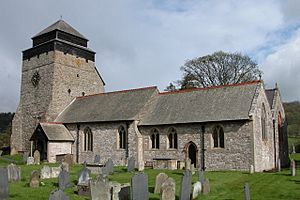James Walton (inventor) facts for kids
James Walton (born April 15, 1803 – died November 5, 1883) was a clever British inventor and a successful businessman. He became famous for making big improvements to the carding process, which is a key step in making textiles like cotton and wool. Thanks to his smart ideas and hard work, he earned a lot of money. He used some of his wealth to buy two large family homes in Wales.
Contents
Early Life
James Walton was born on April 15, 1803, in a place called Ripponden. His father, Isaac Walton, worked as a friezer, which means he helped finish fabrics to make them look nice and feel soft.
Starting His Business
In 1822, James Walton moved to a small workshop near North Bridge, Halifax. He wanted to create new machines for friezing fabrics. He quickly came up with good ideas. By 1824, he moved to a bigger factory in Sowerby Bridge.
In his first year there, he invented a new way to frieze a type of ribbon called "Petersham". He also built the biggest planing machine in the United Kingdom. A planing machine is used to smooth out metal or wood.
In the early 1830s, Walton created a new kind of wire-card for making textiles. Before this, these cards had a leather back. Walton changed this by using india rubber (a type of natural rubber) on cloth instead. This new system was much better. It soon became the standard way to make these cards in the textile industry. This invention helped him get his first patent, which protected his idea.
Moving to Manchester
In 1838, James Walton joined a company in Manchester called Parr, Curtis and Co. Here, he started making his special cards using machines instead of by hand. He bought an American machine that set the cards and made it work much better.
In 1839, Walton had to go to court because another company was using his carding invention without permission. This case, called Walton v. Potter and Horsfall, lasted until 1843. Walton won the case, but it made him dislike legal battles for the rest of his life. In 1842, a fire almost destroyed the factory where Curtis, Parr, and Walton worked.
During the 1840s, he received more patents for new improvements to his machines and how things were made. The partnership with Parr and Curtis was very successful. Their company moved from its first location to a much larger factory in Ancoats.
Haughton Dale Mills
In 1853, Walton left the partnership with Parr and Curtis. He decided to build his own new factory in Haughton Dale, which is south-east of Manchester. This new factory opened in 1857. He started a new company called James Walton & Sons. This company supplied machines and cards to textile factories in Great Britain and other countries. His factory was the largest of its kind in the world!
His sons, William and Frederick, joined him in the business. However, Frederick left in 1863 to work on his own invention, which was Linoleum (a type of floor covering). The Haughton Dale Mills, as the factory was known, was described by a newspaper as "the largest establishment of the kind in the world."
James Walton was a very successful businessman and inventor. People said he had amazing ideas, like other great leaders of industry who helped England become a top manufacturing nation. He was known for his strong will and clear vision. He left behind many original ideas that helped the cotton spinning trade grow a lot.
In 1875, Walton started building the Anglican Church of St. Mary the Virgin in Haughton Dale. It was officially opened in 1876. He also built the Haughton Dale Mills School in the village. In 1887, James Walton & Sons showed one of Walton's card-setting machines at a big event called the 1887 Manchester Jubilee Exhibition.
Homes in Wales
In the 1850s, Walton lived at Compstall Hall, south-east of Manchester. In 1860, he bought a large estate called Cwmllecoediog near Aberangell in Wales. He spent a lot of his time there.
In 1868, Walton bought an even bigger estate called Dolforgan Hall near Kerry, Powys. This estate covered about 4,250 acres (about 17 square kilometers). From 1870, Dolforgan Hall became his main home. He let his sons, William and Frederick, live at Cwmllecoediog.
In 1877, Walton served as the High Sheriff of Montgomeryshire, which was an important local role. He gave a lot of money to St. Michael's Church in Kerry. He paid a large amount to help rebuild the church in 1882.
James Walton passed away on November 5, 1883, at Dolforgan Hall. After he died, his family sold the Dolforgan Estate.
Family Life
James Walton married Anne Kenworthy, who passed away in 1885. They had two sons, William and Frederick, and a daughter named Anne.



